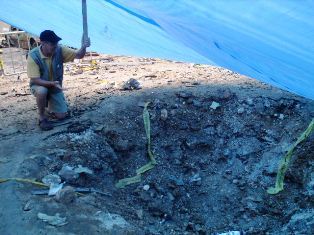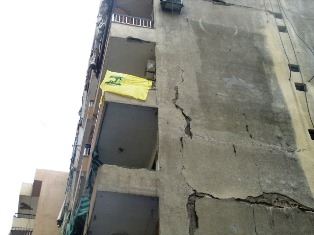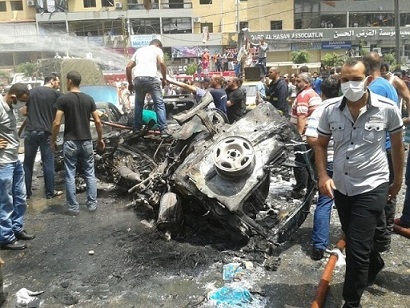This observer’s neighbors seemed to believe, especially over the past year, as most of us did, that the war in Syria would, in one form or another, spill into our neighborhood, Dahiyeh
Dahiyeh, Beirut
This observer’s neighbors seemed to believe, especially over the past year, as most of us did, that the war in Syria would, in one form or another, spill into our neighborhood, Dahiyeh, the Hezbollah stronghold in south Beirut.
As this observer left his flat this morning and walked toward his motorbike on Abbas Mousawi Street en route to Shatila Palestinian Camp for a 10:30 a.m. appointment, at precisely 10:15 a.m. there was a tremendously loud blast. It seemed to shake our massive 12 story apartment building which had been rebuilt by the WAAD (“promise”) Hezbollah construction enterprise, from the mountain of rubble it was turned into in July of 2006. Leveled six years ago as much of this neighborhood was, by American weapons in the service of the Zionist regime still occupying Palestine.
Contrary to media reports, the blast was not on my street, Abbas Mousawi, behind Bahman Hospital, but rather down a side street one block over and two blocks east near the Hezbollah sponsored Islamic Cooperation Center in the area of Bir al-Abed. The explosion occurred close to the Coop supermarket and Salah Ghandour Square.
Jumping on my motorbike I was among the first to arrive on the scene face to face with an inferno that initially seemed to engulf ten or so cars in a parking lot surrounded by eight or nine Waad built high-rise apartment buildings, being a few of the more than 153 residential buildings in our neighborhood leveled during the 33 day July 2006 aggression.
Finally, it seemed like an eternity, fire trucks arrived and made their way thru the rapidly expanding chaos as nearby residential buildings with windows blown out started to empty of their inhabitants amidst fears that another blast may be triggered. A few men joined this observer in pulling the very long hoses close to the inferno as medics arrived and searched for injured. I saw dozens of neighbors being treated, including several children, at nearby Bahman Hospital and others rushed to Rasoul al-Alham hospital and Cardiac Care Center, ten minutes away on airport road.
I observed a six feet by six feet by around eight foot deep crater at the blast site. As I watched the Red Crescent and Hezbollah emergency services staff care for the injured and the many that were traumatized, the crowd quickly grew to a few thousand, with fear, shock and anger spreading. Many elderly slumped against walls and curbs dazed while neighbor helped neighbor, especially the young to cope with the effects of the blast which shattered windows and caused serious damage to several nearby residential buildings, including cracks in their walls. There was much panic and shouting, with crying turning to anger and with people caring for the elderly and children with apartment building entrances set up as emergency treatment areas and neighbors were helping neighbors and reassuring one another. For an outsider, Dahiyeh residents seem to have a special esprit de corps.
The Hezbollah neighborhood of Dahiyeh has been for years considered the safest residential area of Beirut due to strong Hezbollah security measures which over the past year have been intensified. Yet, as Syria’s President Bashar Assad noted several months ago, despite intensive security measures taken in Damascus, it is still very difficult to prevent car bombings.
 The speculation has already started concerning who committed this act of terrorism, one day before the start of the Holy Month of Ramadan. Whoever is was who caused the carnage; it was evidently by booby trapping a 1998 Renault Rapid or a stolen four-wheel-drive Nissan—authorities are apparently not yet sure.
The speculation has already started concerning who committed this act of terrorism, one day before the start of the Holy Month of Ramadan. Whoever is was who caused the carnage; it was evidently by booby trapping a 1998 Renault Rapid or a stolen four-wheel-drive Nissan—authorities are apparently not yet sure.
No one has yet claimed responsibility and likely will not. Hezbollah’s International Relations official Hezbollah MP Ali Ammar told al-Manar that the blast was carried out by the supporters of the so-called American-Israeli project. “There are clear Israeli fingerprints,” Ammar said as he inspected the damage.
The Bir al-Abed bombing occured not far from the spot where President Reagon’s aid, William Casey ordered the 1985 CIA bombing that targeted Shia cleric, Sayed Mohammad Hussein Fadlallah, in which 80 citizens were murdered and more than 200 wounded, is interpreted but some of the residents in my building, (two families so far telling me they will move), as simply a message for Hezbollah to leave Syria. Some local residents told this observer that if it was a typical al Qaeda operation aiming at maximum civilian deaths, detonating the blast a few hundred yards in any direction would have left many more victims, according to a Hezbollah bomb speci alist.
alist.
This observer initially counted 15 destroyed vehicles and more than 20 damaged. A fierce fire erupted among some of the vehicles sending thick black smoke billowing high into the sky. I also saw gentlemen who I assumed was the parking lot attendant badly wounded. Another wounded man near him seemed also to be in serious condition.
Reuters reported that five were killed but Hezbollah is denying this report and I met the Hezbollah Media director on the scene and his job was to get the facts straight before the Party of God made any announcements.
For many in my neighborhood, a major concern is that Syria’s troubles will reopen the wounds of Lebanon’s long civil war but this time with the Sunni community, which by and large supports the Syrian opposition, being pitted against Hezbollah, the powerful Shite led Resistance organization which supports Syria President Bashar al-Assad.
A reliable source, acting Health Minister, Amal MP Ali Khalil, has just advised that 54 have Bir al-Abed residents been wounded and so far no confirmed fatalities have been reported.
Franklin Lamb is doing research in Lebanon and Syria and is reachable c/o fplamb@gmail.com